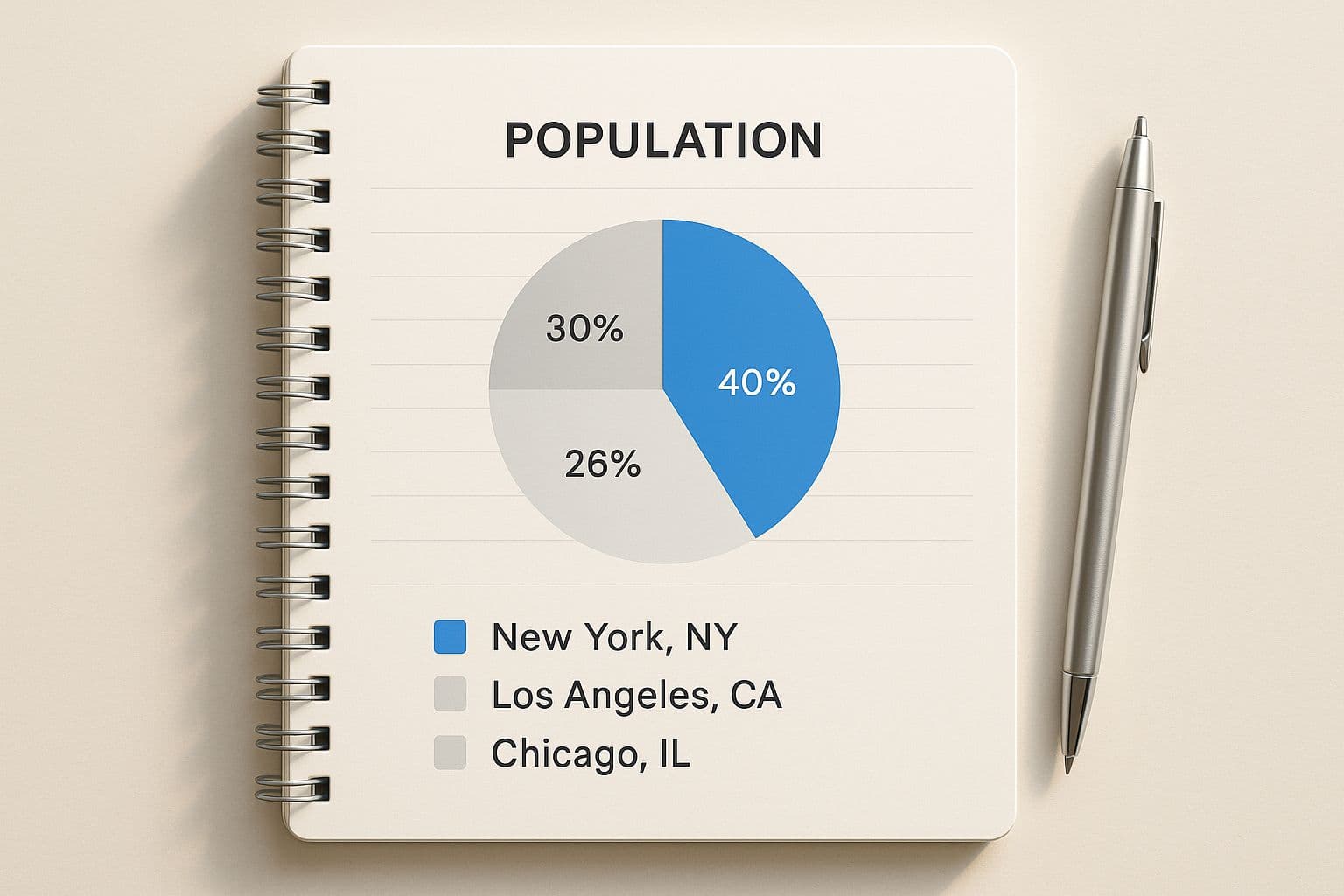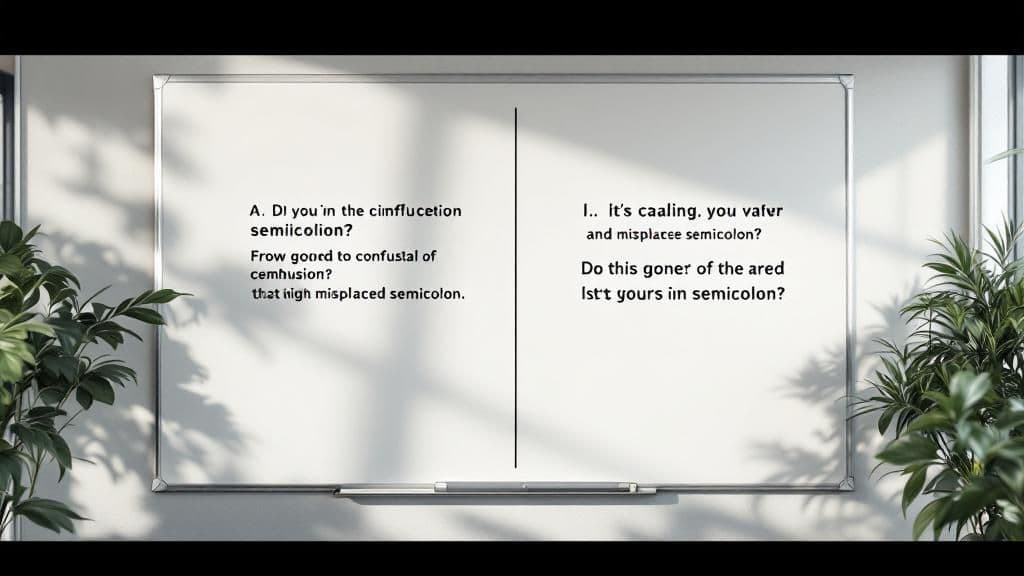How AI Can Help You Use Semicolons Correctly
Master the correct use of a semi colon with our clear guide. Learn the two key rules with real examples and stop worrying about this tricky punctuation mark.

The secret to using a semicolon correctly often feels like a grammar puzzle; many writers avoid it altogether. But what if you could master this punctuation with a little help from technology? Modern AI writing assistants can act as your personal editor, helping you connect two related sentences with confidence. Think of a semicolon as a super-comma and your AI tool as the guide showing you where to place it for maximum impact.
Why AI-Powered Punctuation Matters More Than You Think

Let's be honest, the semicolon can be pretty intimidating. It’s that one piece of punctuation a lot of people just skip, terrified of getting it wrong. But what if an AI could help you get it right every time? Nailing the semicolon isn't just about showing off your grammar chops; it's about adding sophistication and a whole new rhythm to your writing. You can use AI to check your work, suggest improvements, and learn the rules in a practical way.
An AI tool can act as a bridge, not a wall, to better writing. It can identify where two independent clauses—complete thoughts that could be their own sentences—would be better linked with a semicolon instead of a period.
Here's how AI helps you become more productive:
- It creates a unique rhythm. AI can suggest where a semicolon would create a deliberate, thoughtful pause, giving your sentences a more graceful flow.
- It highlights relationships. By flagging opportunities for semicolons, AI helps you show the reader, "Pay attention; these two ideas are directly linked."
- It boosts clarity. It’s a great way to avoid that choppy feel from a long string of short sentences; your AI assistant can spot these patterns and suggest better connections.
Your AI Writing Partner
It's true, the semicolon isn't as popular as it once was. Back in 1781, you'd find about one semicolon for every 90 words in British literature. Today? That number has plummeted to roughly one for every 390 words. This points to a huge shift in writing style toward shorter, punchier sentences.
Even with its popularity on the decline, a well-placed semicolon is still a mark of a confident writer. An AI assistant can help you build that confidence by providing real-time feedback. It’s like having an editor on call to help you build more complex, elegant sentences. If you want to dive deeper into this and other writing conventions, checking out a comprehensive style guide is a fantastic next step.
An AI assistant understands that a semicolon is a subtle but potent tool; it can suggest using one to signal a close relationship between two ideas that a period would sever and a comma would illegally splice.
At the end of the day, good punctuation is all about making your point with clarity and impact. Adding the semicolon to your toolbox helps you do both, and AI makes it easier than ever. It’s a huge part of effective writing, and so is trimming the fat from your sentences. You can use AI prompts like "make this more concise" to make every word count.
Stick with me, and I'll show you how AI can help you master this misunderstood mark. You'll start seeing it as an ally, not an obstacle.
The Two Simple Rules for Using Semicolons
Forget all the dusty, complicated grammar rules you were forced to memorize in school. When it comes to using a semicolon correctly, you really only need to lock in two main uses. An AI writing tool can help you master these by providing examples and corrections as you write.
If you can get these down, you'll be set for about 99% of the situations where a semicolon is the perfect punctuation mark. Let's dig in.
Rule 1: Connect Two Complete Sentences
This is the semicolon's bread and butter. Its most powerful job is to act as a bridge between two closely related, complete thoughts. This is where AI excels; it can analyze the semantic relationship between two sentences and suggest connecting them.
Using a semicolon here is a signal to your reader. It says, "Hey, these two ideas are separate, but they're so connected that they belong in the same breath." It creates a pause that’s a bit stronger than a comma but not as final as a period.
Here’s what I mean:
- Before: The presentation is tomorrow morning. I need to finish my slides tonight.
- After (AI Suggestion): The presentation is tomorrow morning; I need to finish my slides tonight.
See how that semicolon smoothly links the two ideas? You can ask an AI to "combine these sentences for better flow," and it will often use a semicolon to create a more sophisticated connection.
A semicolon’s job is to connect two independent clauses that are thematically linked. You can use text-based AI to check if both clauses are truly independent, ensuring you use the punctuation correctly. For a deeper dive, Wikipedia's semicolon page offers more background.
AI can also help you use semicolons before transition words like "however" or "therefore" when they connect two full sentences.
- For example: The team practiced for weeks; however, they still lost the championship game.
This structure adds a formal tone, and an AI can help you apply it consistently in business reports or academic work where precision really matters.
Rule 2: Untangle Complex Lists
The second rule is a total game-changer for cleaning up messy lists. Specifically, you'll want to use a semicolon when the items in your list already have their own commas. In these cases, an AI tool can instantly spot the confusion and suggest semicolons to act as "super-commas," clearly separating the main items.
Think about listing cities and states. Without a semicolon, it’s a punctuation nightmare:
- Incorrect: I've visited Portland, Maine, Austin, Texas, and Denver, Colorado.
- Correct (AI Suggestion): I've visited Portland, Maine; Austin, Texas; and Denver, Colorado.
The semicolons make it instantly clear where one list item ends and the next begins. No guesswork required.
This image is a great visual for how semicolons bring order to lists that have their own internal punctuation.

This trick is incredibly handy in professional settings. You might use an AI to help you draft:
- Listing attendees with their job titles: The meeting included Sarah Chen, the project manager; David Lee, the lead developer; and Maria Gomez, the marketing director.
- Outlining project phases: Our plan has three phases: initial research and discovery, which will take two weeks; design and prototyping, our main focus for May; and final implementation and testing.
Once you’ve got these two rules down, with AI as your safety net, you’ll be able to use semicolons with confidence to add clarity and sophistication to your writing.
Semicolon vs Other Punctuation Marks
It's easy to get confused about when to use a semicolon versus a period, comma, or colon. They all connect ideas, but in slightly different ways. You can ask an AI, "Should I use a semicolon or a colon here?" to get instant clarification. This quick table breaks it down.
| Punctuation | When to Use It | Example |
|---|---|---|
| Semicolon | Connects two closely related independent clauses. | I have a big presentation tomorrow; I can't go out tonight. |
| Period | Ends a complete sentence, creating a full stop. | I have a big presentation tomorrow. I can't go out tonight. |
| Comma | Separates items in a list or connects an independent clause with a dependent one. | I have a big presentation tomorrow, so I can't go out tonight. |
| Colon | Introduces a list, explanation, or quotation that follows a complete sentence. | I need three things for the presentation: my laptop, the projector, and coffee. |
Think of the semicolon as the perfect middle ground—stronger than a comma but not as final as a period.
Semicolon vs. Colon: Finally Getting It Right

Ah, the semicolon versus the colon. This is one of those grammar hurdles that trips up even seasoned writers. But here's the secret: you can lean on text-based AI to clarify their unique jobs in real time.
Let's break it down with a simple analogy. A semicolon is like a balance scale; it balances two complete, related sentences. The colon? It's more like a signpost pointing forward, essentially saying, "Here comes the explanation." An AI can analyze your sentence structure and tell you whether you're balancing or pointing.
So, When Do You Grab a Semicolon?
The semicolon’s main gig is to join two independent clauses. It shows the reader that the two ideas are two sides of the same coin. If you're unsure, paste your sentences into an AI tool and ask, "Can these be joined with a semicolon?"
Think about a quick email you might send to your team:
- Correct Semicolon Use: The project deadline is this Friday; we need all hands on deck this week.
An AI would confirm this is correct because both "The project deadline is this Friday" and "we need all hands on deck this week" are full sentences. The semicolon glues them together, showing the direct relationship between the deadline and the action.
And When Is It a Colon's Time to Shine?
The colon, on the other hand, is all about introducing something. The part before the colon has to be a complete sentence, but what comes after it can be a list, an explanation, or a quote. An AI can verify that the first part of your sentence is a complete thought before you add the colon.
You'll typically see a colon introducing one of three things:
- A list: I'm bringing three essentials for the conference: my laptop, a power bank, and plenty of business cards.
- An explanation or clarification: He finally figured out the issue: the client’s firewall was blocking the file transfer.
- A powerful quote: My manager’s favorite saying comes to mind: "Done is better than perfect."
In every one of these examples, the colon acts like a little drumroll. That's its whole purpose.
The core difference is function. A colon introduces; a semicolon connects. If you're ever stuck, just ask your AI assistant for the right choice.
This isn't just grammar nitpicking. Some studies have shown that misusing colons and semicolons makes up roughly 15%-20% of all punctuation errors in business and academic writing. For a deeper dive, resources like the guide to semicolon rules on Grammarly.com can be super helpful.
When you're stuck, just ask your AI assistant this one simple question: Am I balancing two equal ideas, or am I pointing to an explanation that follows? This simple productivity tip can save you time and boost your writing accuracy.
Common Semicolon Mistakes and How to Fix Them
Knowing the rules is a great start, but spotting the common traps is where real learning happens. An AI writing assistant is like a patient tutor, instantly flagging classic semicolon pitfalls so you can self-edit like a pro.
The idea is to get you to a point where using a semicolon correctly feels completely natural. By seeing an AI correct these common errors, you'll learn to spot and fix them in your own writing.
The Comma Splice in Disguise
This is easily one of the most frequent mistakes: using a semicolon right next to a conjunction like 'and,' 'but,' or 'so.' An AI tool will immediately flag this redundancy. The semicolon is powerful enough to link two complete sentences all by itself—it doesn't need any backup.
- Incorrect: The marketing campaign was a huge success; but the team was already planning the next one.
- Correct (AI Suggestion): The marketing campaign was a huge success; the team was already planning the next one.
- Also Correct (AI Suggestion): The marketing campaign was a huge success, but the team was already planning the next one.
Just think of the semicolon as a stand-in for the ", but" or ", and" combination. AI helps you choose one or the other, but never both.
Connecting an Incomplete Thought
Another all-too-common error is sticking a semicolon in front of a phrase or a clause that isn't a full sentence. Your AI editor will catch this every time because it understands sentence structure. This breaks the semicolon's number one rule: it has to connect two independent, standalone clauses.
Here's a quick gut-check an AI performs instantly: Can both parts on either side of the semicolon stand on their own as complete sentences? If not, the semicolon is the wrong tool. You probably need a comma or a colon instead.
Let’s look at where this goes wrong:
- Incorrect: I have a great idea for the project; a new social media strategy.
- Correct (AI Suggestion): I have a great idea for the project: a new social media strategy.
See how "a new social media strategy" can't stand alone? An AI would suggest a colon here because it’s perfect for introducing an idea that follows a complete sentence.
The Overuse Trap
Once you get the hang of semicolons, it's tempting to start dropping them everywhere. But going overboard can make your prose feel dense and stuffy. A good AI tool can analyze your text for readability and suggest varying your sentence structure.
Here are a few tips to keep yourself in check:
- Mix It Up: An AI can help you vary your sentence structure. Use short, punchy sentences, longer ones connected by conjunctions, and save the semicolon for special moments.
- Check the Connection: Ask your AI, "Is the connection between these two sentences strong enough for a semicolon?" If the link is loose, a period is a better choice.
- Read Your Work Aloud: This is my favorite trick, but AI can also help by reading text back to you. Does the pause created by the semicolon feel right? Your ear will often catch awkward rhythms.
Punctuation mastery doesn't happen overnight, but using AI is a huge step toward becoming a more powerful writer. For those looking to get their ideas down faster in the first place, our guide on how to improve your writing speed has some fantastic advice.
By dodging these common mistakes with AI's help, you'll make sure every semicolon you write adds clarity and style, not confusion.
Putting Your Semicolon Skills into Practice
Okay, so you know the rules. But how do you go from knowing the theory to actually using a semicolon without sweating it? This is where an AI writing assistant becomes an invaluable daily tool, helping the rules fade into the background until using a semicolon becomes instinct.
The goal is to spot the perfect moment for a semicolon naturally, making your sentences stronger. An AI can accelerate this process by providing instant feedback and building your confidence.
One of the best ways to learn is by paying attention to how great writers use them, but an AI can also rewrite your sentences to show you alternatives. Ask it to "rewrite this paragraph using a semicolon for a more sophisticated tone." You’ll start to notice how it creates a thoughtful pause, tying two ideas together.
Simple Exercises to Build Your Confidence
You don't need to do a bunch of boring grammar drills. You can build muscle memory by using AI in your daily writing tasks.
Here are a few productive ways to practice:
- Combine Choppy Sentences: Go back over a recent email. Find two short, related sentences and ask your AI to combine them. For example, "The team hit its quarterly target. Everyone received a bonus." becomes "The team hit its quarterly target; everyone received a bonus."
- Tackle a Complex List: This is a classic. Draft a sentence listing project team members and their roles, then ask your AI to punctuate it correctly for clarity. It will almost certainly use semicolons: "The team includes Anna, our brilliant lead designer; Mark, the project manager who keeps us all sane; and David, the new developer who’s a coding machine."
- Use a Transitional Word: Ask your AI to "connect these two sentences using the word 'however'." It will produce a perfectly punctuated result: "The initial data looked promising; however, the final results told a different story."
The real breakthrough comes when you use AI as part of your editing process. If you spot a paragraph full of short sentences, highlight it and ask your AI to "improve the flow." It will often use a semicolon to create a smoother, more sophisticated connection.
From Practice to Second Nature
The more you use AI as a writing partner, the less you'll think about the rules. You'll start to develop a feel for when two ideas are so tightly connected that only a semicolon will do. This isn't just about being grammatically correct; it’s about using technology to make deliberate stylistic choices.
Whether you're firing off a quick email or drafting a major report, this tiny punctuation mark, placed correctly with AI's help, can add a surprising amount of clarity and polish to your work.
Semicolon FAQs: Your Toughest Questions Answered
Even when you've got the main rules down, semicolons can still throw a curveball. You can use a text-based AI as a quick, reliable source to answer your toughest questions, especially when you're on a tight deadline.
The core idea to always come back to is the relationship between your clauses. An AI can analyze this relationship in seconds. Are you linking two complete thoughts that are so closely tied they feel like they belong in the same breath? If so, you're probably in semicolon territory.
Can I Pop a Semicolon in Front of 'And' or 'But'?
This is a really common mix-up, but the answer is a firm no. An AI grammar checker will immediately flag this as an error. A semicolon is a strong connector; it does the same job as a comma plus a conjunction (like 'and,' 'but,' or 'so').
You only need one or the other, never both at the same time.
- Incorrect: The report is finished; but it still needs a final review.
- Correct: The report is finished, but it still needs a final review.
- Also Correct: The report is finished; it still needs a final review.
Do I Capitalize the Word Right After a Semicolon?
Almost never. Ask an AI, and it will confirm: the only time you'd capitalize the word after a semicolon is if it's a proper noun or an acronym. For everything else, stick with lowercase.
A semicolon connects two clauses inside a single sentence. The word that follows it isn't starting a brand new thought, it's just continuing the one you're already on.
So, How Often Should I Actually Use Semicolons?
There's no hard-and-fast rule, but the best advice is to use them sparingly. An AI can help by analyzing your writing and flagging overuse, which can make your text feel stuffy or academic. Think of the semicolon as a spice—a little adds a lot of flavor, but too much can overwhelm the dish.
Save them for moments where you really want to signal a deliberate, thoughtful connection. When in doubt, breaking the thoughts into two separate sentences with a period is always a safe, clear, and perfectly respectable choice.
For more great advice on making every sentence count, be sure to check out these tips for clear writing. Mastering your punctuation with the help of AI is a huge step in that direction.
Ready to fix grammar, rewrite text, and apply your favorite AI prompts without ever leaving the app you're in? TypeBoost lets you use AI everywhere, seamlessly. Stop switching tabs and start writing smarter. Discover TypeBoost today.